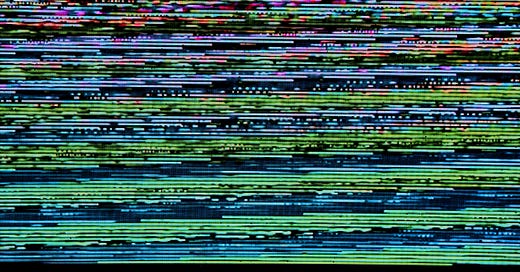This is a post about naming. As we’ve moved to a new town, we get asked quite a bit about how we came up with our children’s names. “He has a family name.” “His middle name is an homage to our years in Scotland.” “One of her middle names is after my PhD supervisor.” “This is the virtue we hope he embodies.” We not only name based on future hopes or to memorialize our stories, but we also name to notice.
This is my act of noticing — putting words around our worlds. Come, let us notice together.
Last week, I wrote about the challenge of our vocabulary — how the language of the therapeutic age has infiltrated how we think about everything. It is the schema by which we ascertain health and growth. I then examined the impact particularly on church leaders: they’re hamstrung, unable to press into harder questions or challenges (and, if they do, they can get lumped into a sliding scale of abuse). This isn’t just an isolated problem around one particularly toxic culture.
It is a system.
What many of the conversations around these issues miss is that is not isolated. This therapeutic age is a system.
Back when I was writing my PhD thesis, one way of conceptualizing the work in my field was to take the Atlantic Ocean as the nexus of relation rather than a particular nation-state. So we’d see the way ships traveled across the ocean with sugar, slaves, and money not as isolated activities based on where the ship landed, but how this traveling across was itself the point of connection. Patterns emerged. Goods, services, and traffic were not isolated events but worked together in a system. Yet, the actual pathways of this system was so visible that it had become unremarkable. We forgot it. Instead, we’d evaluated literature only from one vantage point: from that of the nation-state.
Our therapeutic age, likewise, is a system. What’s fascinating is that the system of a therapeutic age works by denying it’s a system. It’s a system that says you get to define who you are while also positing outside forces — family, nation, place, time, bodily constraints, God, faith communities, tradition — as debilitating factors. From these we may pick and choose, as if we were adding toppings to a Subway sandwich, to create our curated, meaningful life.
We imagine ourselves to be isolated actors, looking inside ourselves to create our own realities. But we need some form to hold up this charade.1 Social media is the form par excellence for our therapeutic vocabulary.
Though it denies it’s a system, it is one nonetheless. What does this look like? Let’s take Instagram as one example.

What does this look like?
You jump on when you’re standing in line at the grocery store. You ignore your bodily location and instead imaginatively enter into the no-space and no-time of the app. Here, you imagine, you’ll find relief from monotony or at least distraction. You see a reel for good parenting advice and you remind yourself you really should go back to that. Maybe it’ll be the thing that provides the break-through with one of your children. You see your old neighbors have gone on a holiday to Hawaii. You look longingly at the aqua water. Wondering what you’re doing with your own life (which is that now you’re last-minute boring-dinner grocery shopping). You see a quote about woundedness and depending on the day, resonate, hit the heart button or, if it seems like too much, or too abstract, you just keep scrolling. You see someone telling you how to wear mom jeans or what to do to keep your skin looking youthful. You close the app.
You don’t see this content separately, but together. You aren’t able to pause long enough to look at the smiling faces in Hawaii and remember the times around your dinner table. You don’t take 15 minutes to simply watch the parenting advice reel and do the attending work of application. You don’t take the quote about woundedness to your bible or to prayer. Perhaps separately one of these posts/reels/links might be helpful, but we don’t take in info that way.
We take it together, en masse. We are overwhelmed with information and we never process it separately and at length. Part of the system of the therapeutic age then relies on hurry, the speed of information transfer and the sense that we’re behind before we’ve begun.
If the way the system operates is through FOMO and hurry, the message of this system in the advice/highlight reel/products-to-buy loop is: “You don’t measure up. Here’s how you can measure up.” We measure up through better planning, more creativity with our wardrobe, more self-control, more deep interrogation of our woundedness. And though an individual account may push against this narrative, it is just one small blip in your scroll which is algorithmically construed (which prioritizes the flashiest, most-liked, most-shared items of information). Your attention is the product. Social media does not reward nuance. Your romp through social media is part of a mutually affirming ecosystem that is a self-referencing loop.
It isn’t just out there — those influencers, those thinkers trying to hawk their wares on social media — who live in this fishbowl. It’s all of us. This is the water we swim in. Consider this sentiment from a writer, who has much to criticize about social media stardom but also sees this tendency in herself:
As a writer who often shares her life and work online, I’m aware of my own tendency to post culturally covetable content to my Instagram and Twitter feeds, and of my greedy desire for the niche social capital that I imagine it might bring me.2
If we’re all implicated, then what?
We Must Ask the Questions
That’s why I appreciated the first episode of “The Rise and Fall of Mars Hill” podcast: because Cosper asks what is it in each of us (and I’d ask, what’s in the systems of our culture) that contributes to propping up a power-hungry leader. What’s most interesting isn’t the downfall of one person, but the structures and systems that create the flourishing of those types of churches (or leaders, fill-in-the-blank as you see fit).
Here’s where the questions gets interesting — when we learn to ask:
“What is it about my formation that I’m using the same words as everyone else?” and “Where have I seen this vocabulary?”
“Why do I and why do we conceive of health and wellness as the supreme good?”
“Why does it seem that people now have a hard time with ‘adulting’ or resilience appears too much out of reach?
When we begin to ask these questions, we’re no longer analyzing culture as an artifact from long ago, but as a living, breathing thing as we swim within it. We’re noticing the pathways. We’re calling attention to our own participation in a system.
What is this system that we are a part of? Philip Rieff posits this about this brave new world of the therapeutic man (several decades ago):
The wisdom of the next social order, as I imagine it, would not reside in right doctrine, administered by the right men, who must be found, but rather in doctrines amounting to permission for each man to live an experimental life”3
A place like Instagram provides the contours of “an experimental life.”
***
Here’s the rub: we tend to notice that there is a system at work when it’s on the other side of the aisle. We notice abuse when we have been abused. We notice ‘toxic’ leadership when we’ve been under a ‘toxic’ leadership culture. If I may put it bluntly, we notice what we’ve been freed from, but do not name our own participation in the making of that culture or how we might perpetuate the same things in a different key. We often do not take note to take the log out of our eyes first.
We see all the downfalls of that system over there but never quite get to the ways that we, too, are prone to the same systemic problems. We may be just as judgmental as the legalistic person to our right, but our causes are the correct ones, we reason. We may not be as wishy-washy on that person on the left of us: we do not ignore what is right and good, we reason. (Do note: this is not to say that our ‘causes’ are all relative, but it is to say that we may hold differing convictions through exactly the same posture or tone). Let us not neglect form while we focus on content.
Because when we look closely at form — and Instagram is just one example — we’ll see that it is often form more than content that reveals the system. A system we’re all a part of. It’s as if the angel fish harped on the flounder for his ridiculousness whilst both never realized they were both swimming in water. Both recipients of the same medium. Let us look around and see the water we swim in.
We swim in a system designed to help the modern woman and man create an experimental life. From the language we use, to the wonder it cuts off, to the soothing rather than saving forms of the therapeutic, we must realize we need more than tweaking our digital habits. We need a new system or, at least, a more thorough-going pathway through the one we’ve go. Brandon O’Brien writes on his substack about some questions we could ask ourselves in how we read the bible, being “aware of one’s social location”; that’s one place to start.
I don’t have complicated answers, at least not now.4 But always we must begin by noticing and naming. And always, always, we must draw ourselves low to the earth (“humility” of course comes from hummus, “of the earth”), seeing ourselves truly: as participants in a system. We notice. We name. We hold ourselves lightly.
Be sure to share and subscribe! If you’d like to think together charitably, I’d love to hear your comments.
Share below: Where have you seen systems thinking at work?
For Fun, Housekeeping, etc.
If you are of a certain age, perhaps when I talk about systems, you may think of this from Strong Bad. Thank you and you’re welcome.
Other parts of this series on the therapeutic age are below:
If you missed it, on the podcast we’ve had Glenn Packiam on resilience in the church (Episode 135) and Gem Fadling on your thought life (Episode 134).
I’m now producer The Russell Moore Show at Christianity Today. I’d love to hear what you think and send your questions to questions@russellmoore.com.
This substack is a labor of love. Thanks for reading, sharing and subscribing!
Photo by Michael Dziedzic on Unsplash
I’m thinking here of Yuval Levin’s A Time to Build where he talks about institutions as durable forms of community. I liken it to a baking pan (in this piece for Common Good Magazine); things need a form to be what they are to be — from a cake to people, ideas, cultures and communities.
Naomi Frye, “‘Fake Famous’ and the Tedium of Influencer Culture,” The New Yorker, https://www.newyorker.com/culture/on-television/fake-famous-and-the-tedium-of-influencer-culture
Philip Rieff, The Triumph of the Therapeutic: Uses of Faith After Freud, 20.
My husband has been reading Biblical Critical Theory and as soon as I can get my hands on it, I am hopeful it will provide some answers here.





Congratulations on the new producer role, Ashley!! And this series you’re doing is fabulous.
My 2021 book, Not Quite Fine: Mental Health, Faith, and Showing Up for One Another, attempts to take a systems look at mental health, suggesting that communities of meaning, belonging, purpose, value and hope are foundational to good mental health. That the individualization inherent in therapeutic culture can not just fail people but perpetuate their problems.